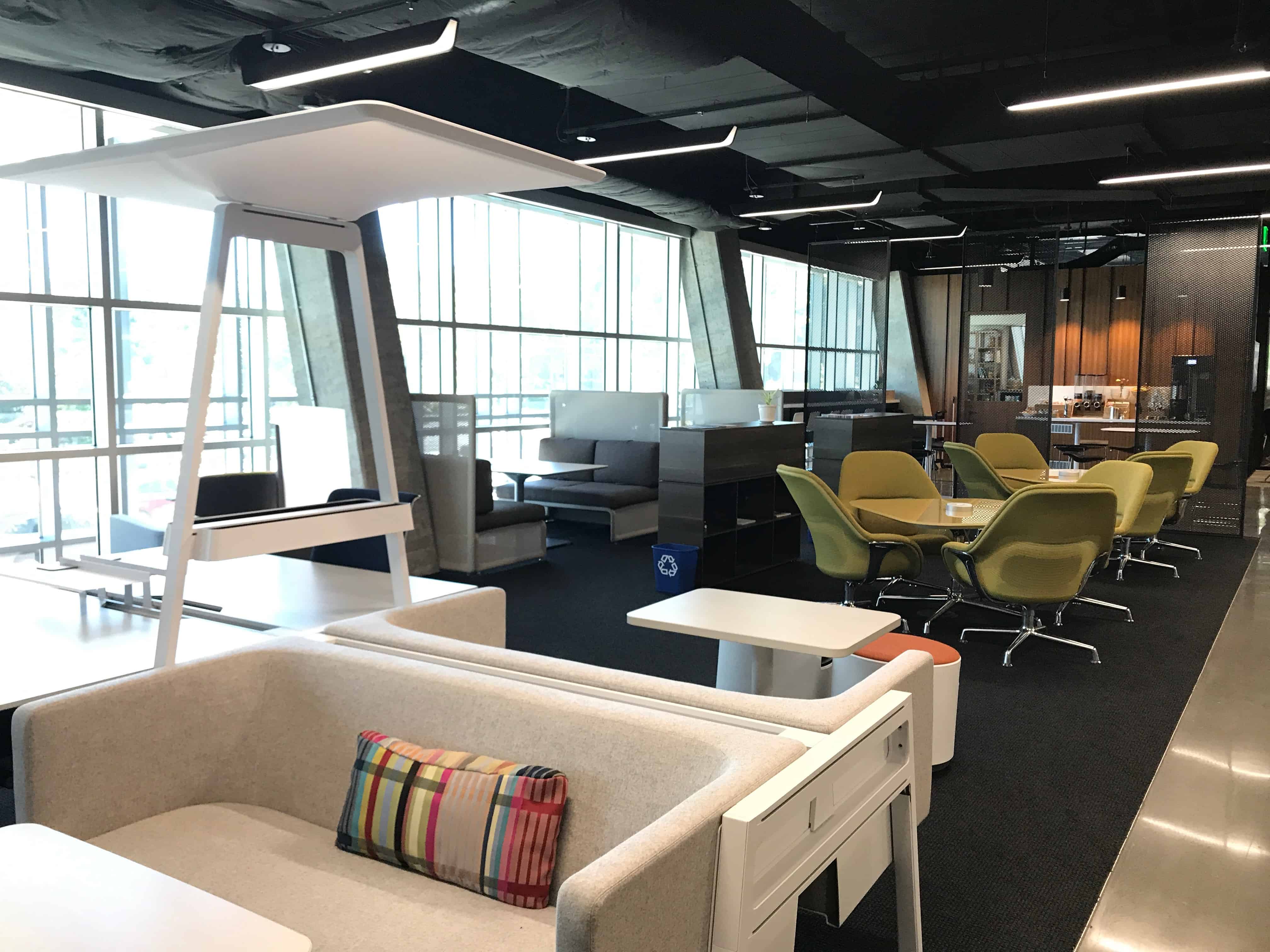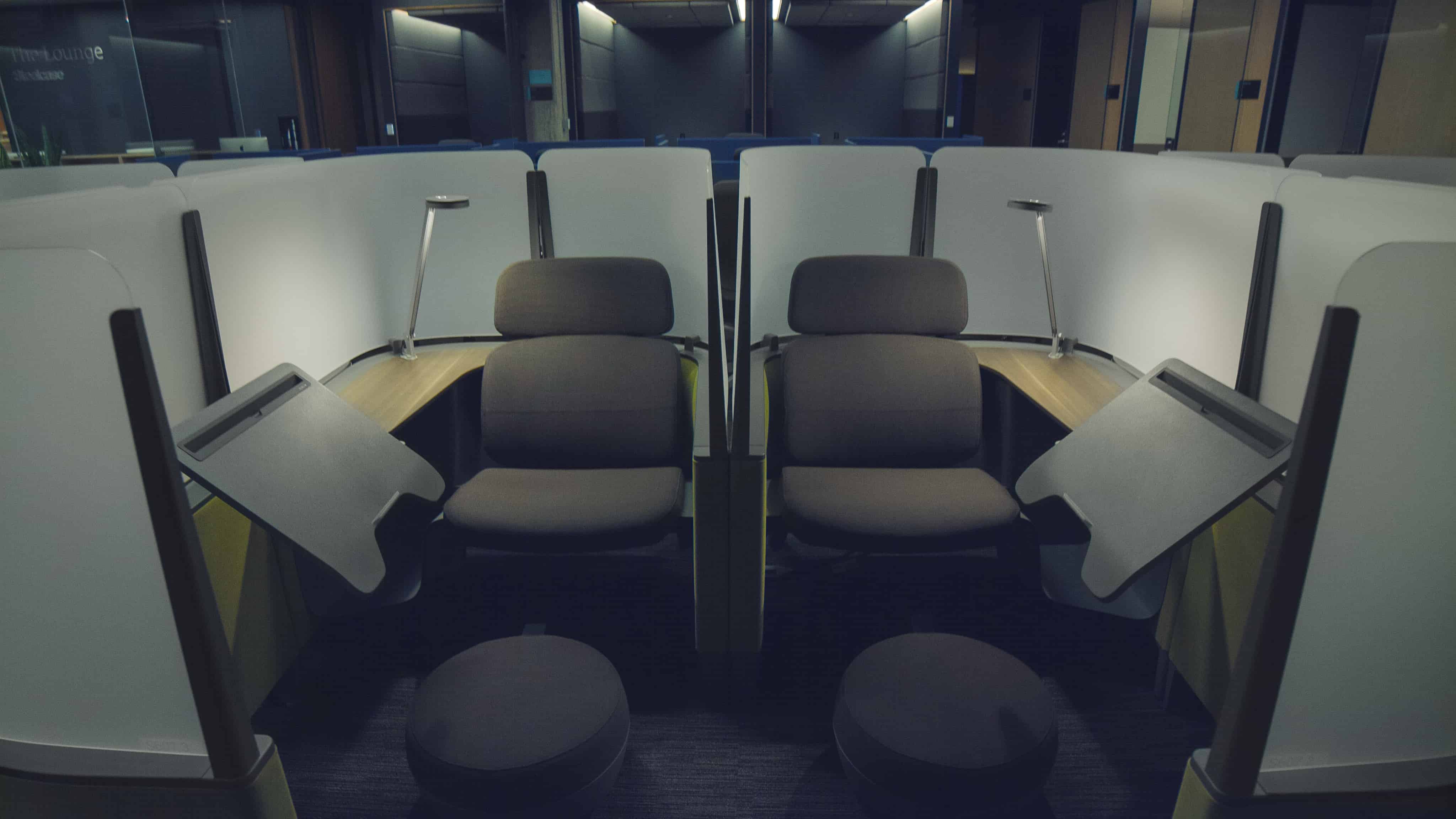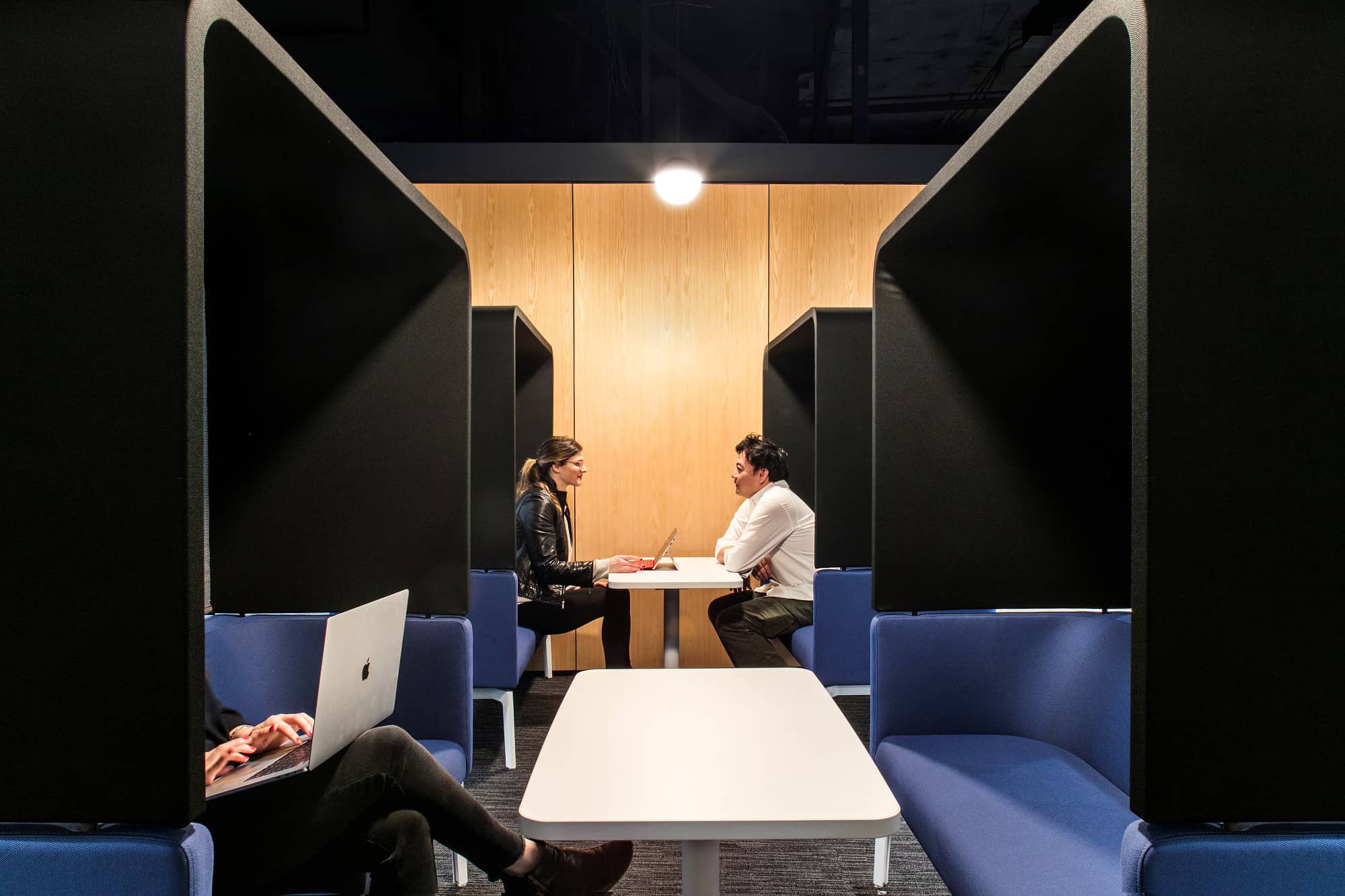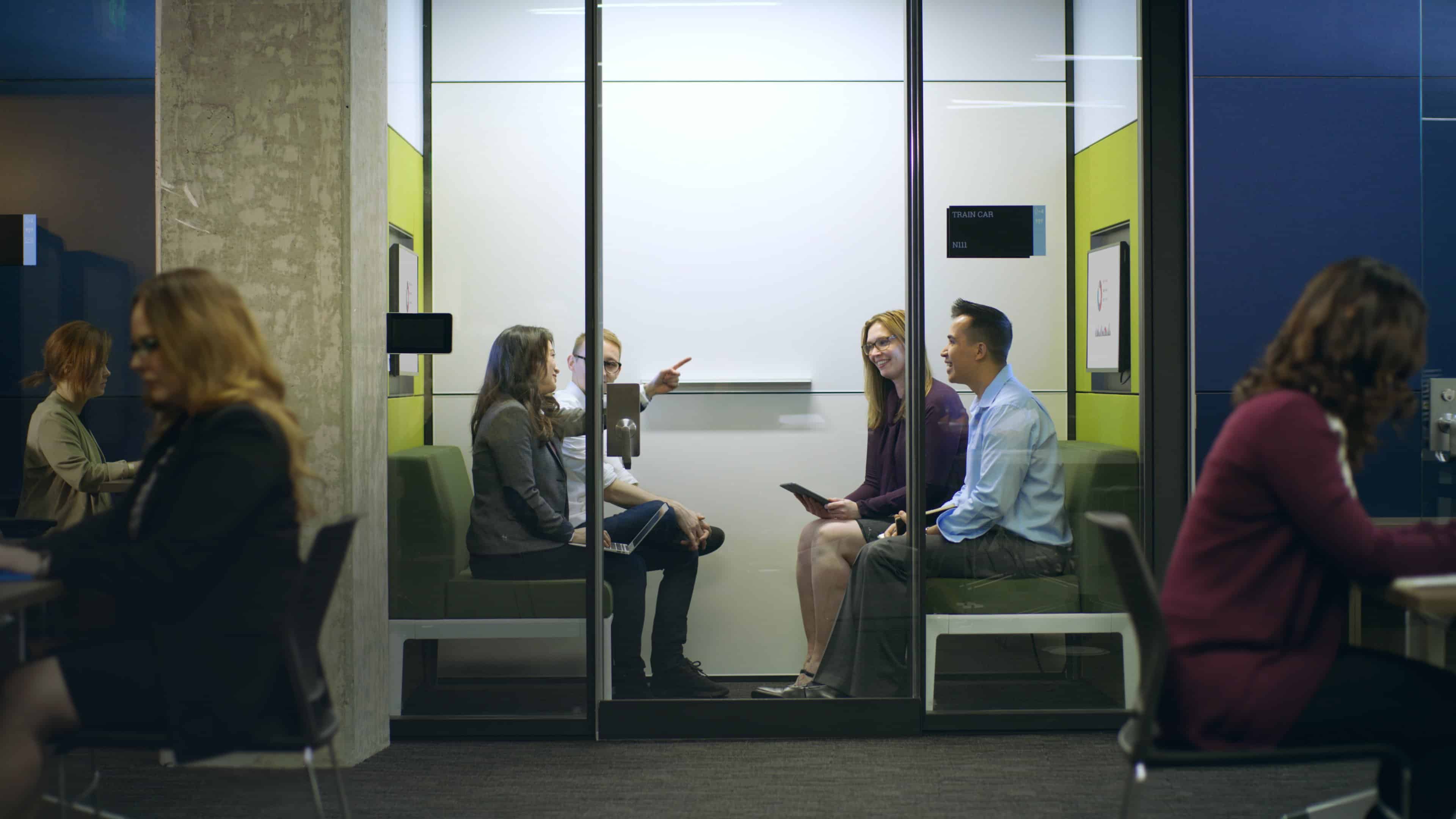The Emergence of Collaborative Workspaces
During the industrial age, workplaces were physically hierarchical: The boss had a “corner office” which afforded privacy and symbolic privilege while employees had little or no privacy. This model held for a long time – the “corner office” and “window office” were sought-after spaces enjoyed by leaders or authority figures, while rank-and-file worked in exposed areas at banks of desks or tables, or along factory assembly lines.
As the 1980s approached, though, workspace designers realized that for efficiency’s sake, workers needed more privacy. Thus began the cubicle phenomenon, popularized in Dilbert cartoons and movies lampooning corporate culture. The cubicle was an economical workspace with partial privacy, in the form of cubicle walls. Occupants didn’t stare at each other, but they could still hear each other or enter one another’s “work rooms” unbidden, since cubicles are only enclosed on two or three sides. Conference rooms were also a feature of the traditional 20th century office — booked in advance or used when guests came to visit, these large rooms often would sit empty except during special occasions or important meetings.
Fast-forward to the 1990s, the first dot-com boom, when technology and media entrepreneurship were rising fast. As startups proliferated and digital and other technology companies rapidly formed, and large corporations turned their attention to in-house “innovation” groups, a more open and informal work environment emerged — the collaborative workspace. Employees had their own seats, but brainstorming and idea-exchanging happened in open areas, over Foosball tables or kegs in the kitchen, at write-on, wipe-off boards and on the backs of napkins.
As the startups grew up, so did their workers and investors — and so did the contractors and freelancers who worked for them. By the mid-2000s, freelance office spaces emerged to serve a group the economic development and city planning guru Richard Florida liked to call the “creative class”— a mix of media, academic, artistic, and ideas-driven professionals. Many of these people worked as freelance contractors but needed a professional environment or community where they could exchange ideas with partners and clients. These freelance office spaces became known as co-working spaces (or “coworking” spaces), and they proliferated in busy, hip cities like San Francisco, Denver, New York, LA, and Seattle.
While independent co-working businesses arose to meet the needs of gig workers, corporations hoping to attract young, hip, tech-savvy candidates and others interested in an entrepreneurial culture also began introducing collaborative workspaces and innovation labs. The big idea here is that collaborative workspaces offer a mixing bowl where people of all ages, ranks, and expertise can develop innovative ideas in an entrepreneurial manner - through sharing a physical space.
Technological innovation, a freelance workforce, and pressure for corporations to pivot according to market demand (and to compete culturally with startups) have all contributed to the rise of collaborative workspaces. Some 1.2 million workers worldwide will work from a co-working space in 2017, according to research published in Deskmag.com. Forty percent of workers in America will be independently employed, according to Gensler, an office design and architecture firm.
How Do You Recognize A Collaborative Workspace?
Collaborative workspaces create specific subcultures through space design, and many use tools from the same design toolkit to create different types of workspace within the same office or co-working organization. Research shows that what workers most want – inside a corporation or inside a co-working space – is control over their environment, so workspaces that afford multiple work mode options are likely to satisfy these desires.
Working Alone Together
In Seattle, a new co-working space Type Set caters specifically to writers — with pricing, a no-talking policy, and occasional social activities tailored to this audience. Co-founder Elisabeth Eaves, a journalist and book author, says she and her partner Joe Ray created the space to accommodate writers who can’t typically afford the more tech-focused spaces in town, and because she herself had experienced the need for one. Their space is outfitted with rolling desks (some of which adjust to standing height), comfortable desk chairs, a single large shared table, and a few easy chairs.
Basic membership for access between 5 a.m. and midnight is $150 per month — a bargain for Seattle, but affordable for writers who may earn less than the entrepreneurs and techies who populate many local co-working rosters. The space also offers coffee, tea, Wi-Fi, quiet, flexible desk space (first-come, first-serve), and a refrigerator and microwave. There’s a phone closet for privacy, as well as lockers that are available for a small fee. Though the space lacks a conference room due to its compact size, members can walk just yards to a neighboring café. Type Set is exploring how to serve its members, and holds a monthly happy hour as well as occasional writer-focused events such as a fundraiser for a writers’ residency or events for an investigative journalism organization.
Collaborative Space Can Support Multiple Work Styles Beneath One Roof
Collaborative workspaces take a mix-and-match approach to space usage, so that people can toggle between concentrating and short or long social interactions to let those different work modes inform one another. Here are some common ways office design achieves these goals:
- Casual encounters and day-to-day familiarity breed relationships. In both corporate and co-working settings, casual encounters breed professional partnerships that lead to new ideas, creativity, and entrepreneurship. This learning environment may be attractive to would-be hires at a corporation, or to would-be co-working members hatching plans for new endeavors.
- Workers from different teams, disciplines, and generations work alongside each other. The “vision” people can talk to the engineers and usability experts, the product marketing gurus can talk to the development team about timelines, the PR pros can ask involved questions about technical products or programs, and the philanthropists can get help from the app designers.
- Workers can switch between solo and group work. Workers need easy access to teams and others on their projects, but they also need solo time to do their portion of any project. The space allows for these different work modes.
- Privacy is a strategic option. The worker decides to seek focused time within the space and can find nooks or closed-door rooms to do so. While most of the space is open, privacy is an option.
- Body language sends cues. People may need to learn to communicate when they’re busy versus open to talk. If they’re sitting in a quiet nook with headphones on, they’re busy. If they’re at a long shared table in an open area of the space, they may be doing work that requires less concentration.
- Space allows for different interactions. If someone schedules a meeting at a standup desk in an open area, it’s probably a quick and casual conversation, versus one held in a closed-door private area. The space likely has a gathering area for lectures, talks, lessons, or happy hours — or a kitchen big enough for water cooler chatter.
Collaborative Space Design Features Are Varied
Furniture maker Knoll has stated that the five types of space inside a collaborative work environment ought to include refuges (private space for two or fewer people); enclaves (small team work areas for up to four); team meeting space (small reserved spaces that can accommodate up to eight people); assembly space (for large gatherings); and community space (a comfortable lobby, a shared kitchen).
The concepts identified by Knoll go by varying names depending on the corporation or co-working facility, but generally refer to the following design elements:
- Open Space Rules: The defining characteristic of most collaborative workspaces is open space, punctuated with a wide variety of “sub spaces” that are visible throughout the facility. Open space is often achieved through tall ceilings, banks of windows, glass walls that carry light through the space, and strategically installed flexible lighting.
- Work Productivity Is Visible: Collaborative workspaces don’t wall off people. Members from disparate teams and companies work amidst one another, and even when a team slips into a conference room or a small meeting room, the space is often viewable through glass walls. Privacy is created through ambient noise or sound baffling, and through people’s own ability to modulate volumes and shield materials.
- Open Seating Dominates: Most co-working spaces have first-come, first-serve open seating. The lack of assigned seating is generally not a problem since in a corporation, a known or finite number of people are using the space, and in a co-working office members come and go at different hours. Seating may include large and small tables for workers. Some larger co-working spaces do offer fixed desks for higher monthly membership prices, or closed offices for small teams who need to keep confidential business files or data in a restricted area.
- Flexible Furnishings Abound: Furniture is moveable or adjustable, possibly on casters or adjustable for different work types. Furnishings can be reconfigured for happenings within the workspace – for instance, tables can be quickly moved into a U-formation for a class or workshop, or stacked or rolled away so there’s open space for a happy hour social.
- Mixed Nooks and Workspaces Are Available: Collaborative spaces typically offer a mix of public and closed-door meeting areas, sofas, reading nooks, standup and sit-down tables, focus spaces, and working-alone-in-public spaces. For instance, office furniture designers such as Steelcase are designing partially open work nooks, such as diner-like booths, to give workers a mix of openness and privacy.
- Mixed Meeting Space Metaphors Are Everywhere: Co-working spaces typically offer multiple meeting room types, which can be reserved for team activities, conference calls, or board meetings. Write-on, wipe-off whiteboards and glass walls are common (just take a picture of the notes with your tablet or smartphone). Phone “closets” and two-person work rooms give people privacy for meetings or calls, and are typically closed-door and lined with soundproof materials, reservable on short notice or first-come, first-served.
- Casual Encounters Are Encouraged: Standup or tall bistro tables and a friendly shared kitchen can encourage spontaneous conversations. Free drinks and snacks and cheerful, colorful décor makes the space coffee shop-like and informal. Some spaces even allow members to bring dogs.
- Mobile Workers Can Get Going Quickly: The spaces have a blend of fast Wi-Fi, audio-visual equipment, teleconference and videoconference rooms, printers, fax machines, lockers, phone charging stations, plenty of electrical outlets, and other borrowable gadgets. These systems are simple to use and easy to “plug into” or launch for DIY and one-time users.
- Team Members or Corporate Brands Are Celebrated: Collaborative spaces may celebrate a company’s brand and products, while co-working spaces may celebrate members’ accomplishments and interests in an effort to build community among members.
Collaborative Workspace Missteps
Collaborative workspaces inside large corporations, as well as co-working spaces for workers from multiple backgrounds, do sometimes fall flat. In recent years, many full-time employees have lamented that their companies have carelessly “torn down the office walls” on the premise that this makes the work environment more creative and shrunk the office space available per worker without adequately compensating for the resulting noise and lack of privacy. The Washington Post published a recent opinion article stating that the rise of the open workspace gives some employers “a false sense of improved productivity.”
Here are common mistakes among collaborative workspaces:
- Offering the Wrong Proportion of Subspaces: While a collection of open space, clear-walled conference or phone rooms, and private nooks may add up to a typical-seeming collaborative space, corporate and co-working developers need to assess the demand of each subspace type. Many employees complain of a need for quiet fixed space or private space that ends up serving as flex space — meaning they wind up buying accessories like noise-cancelling headphones to concentrate.
- Overlooking the Inevitability of Hierarchy: Dispensing with assigned seating doesn’t rid a collaborative space of “competition” or “jockeying” for coveted seats. People might not rotate around a space and sample the work vibes from different areas, but instead “stake out” their favorite region in a collaborative office, or use subtle cues to dominate particular portions of the space, thus creating the hierarchy collaborative spaces seek to avoid. Additionally, co-working spaces that overemphasize members from a single industry may inadvertently create an environment that caters to one type of work culture.
- Inadequate Soundproofing and Uncomfortable Seating: Ambient noise from others in the space and unpleasant work furniture are also common complaints, and sometimes their investments in noise-cancelling headphones provide evidence of the “wall” they want between themselves and others. Co-working and collaborative spaces that work well may use white noise, soundproofing, and some screening and padding around particular work nooks to cordon off noise and make for translucent rather than transparent visibility.
- Human Error: Individual personalities can create disruption in a co-working or collaborative space, too. People with poor boundaries or an inability to read others’ social cues, new members or employees who don’t yet have the hang of how the space functions, someone who doesn’t get that their speakerphone call is disruptive all cut into the productivity of a collaborative workspace. Many co-working spaces have “hosts” or desk staff to make sure guests and new members are given an orientation and understand the space, and to gently suggest where a given visitor or member should go work.
- Forced Social Interaction: Some collaborative workspaces are more or less a sort of bullpen (to quote businessman Michael Bloomberg) or work zoo, where everyone’s work is observable 24/7. In a co-working space this is sometimes part of the point, of course, but when a co-working space or corporate collaboration area hosts too many events during some people’s prime work hours or too many hack-a-thons or VC pitch slams, a space meant for productivity can devolve into event center environment.
- Insufficient Privacy: Do phone closets and glass-walled meeting rooms only separate people physically but not acoustically? Do workers have lockers? Can a team camp out in a lockable room while on a sustained project? Privacy considerations do need to come into play: In a co-working space, workers serve multiple employers and need to protect competitive information, while in a single workplace workers want to preserve privacy about their personal lives. A recent New York Times article about shrinking corporate office space and increased communal workspace cited one employee who said private offices need to make a comeback — if only to give staff a borrowable, occasional privacy option. “What people need when they make phone calls isn’t visual privacy, it’s acoustic privacy,” notes Atlas Workbase’s Kim Burmester. “Our phone and videoconferencing rooms have sound-buffered glass doors. Yes, you can see someone talking, but the important thing is you can’t hear what they’re saying.”
The Future of Collaborative Workspaces
The future of corporate offices is shifting. A nine-to-five schedule faces obsolescence in many industries, especially when teams or clients are geographically distributed across U.S. or international time zones, and with technology advances making team members available via more channels at more hours. Technology may mean that productivity now trumps “face time” when it comes to impressing management or hitting workplace goals. The amount of square footage per employee in America is shrinking — not only because businesses are strategically “forcing” collaboration, but also due to real estate expenses. All of these factors play into a future in which workspace planners should assume not every seat is constantly occupied and know that workspaces need to straddle a members’ opposing needs for collaboration and concentration.
Gensler, the office architecture firm in San Francisco, surveys American workplace trends annually, and thus tracks the relationship between workplace design and worker innovation and happiness. In its most recent survey, the company found that innovative workplaces are those that are five times more likely than their peers to focus on both private workspace and collaborative space. The company also reports that workers at the most innovative companies spend 74 percent of their week in the office — versus 86 percent for less innovative companies. Innovative offices give staff more choice in terms of when and where to work, more autonomy, and more work amenities and privileges. The result is happier employs.
Collaborative workspaces are also an important recruiting tool, especially for corporations seeking Millennials. This generation is expected to comprise 40 percent of the workforce by 2020, and 88 percent of them prefer a collaborative workspace and so-called “work-life integration,” according to Forbes. Collaborative workspaces, inside corporations or in the form of co-working spaces, have also become important economic development tools. Some states such as Maine and Massachusetts are allocating funding to support development and support of co-working spaces as an engine for job growth.
The Future of Co-Working: Bigger and More Professional
The future of co-working spaces is changing too. Co-working spaces are getting bigger and more professionally focused. According to research cited by co-working industry publication Deskmag, the average co-working space now has 74 members, up from 49. The number of North American co-working spaces with ten or fewer members has dropped to 12 percent from 23 percent over the past year, while the number of spaces with more than 150 or more members has grown from 13 percent to 20 percent of all spaces. Many co-working establishments strive to serve entrepreneurial people, first as they work independently, then as they accumulate teams, branch offices, and ultimately fixed space.
Mall developers are also contributing to the co-working space development, with large operators like Westfield developing collaborative spaces in North America, GPT Group in Australian malls. Even developers in Kazakhstan are getting in on the action with a 70,000 square foot co-working environment called Multispace.
Hospitality Takes Center Stage in New Co-Working Spaces
Atlas Workbase, a new co-working space in Seattle with plans to add nine more West Coast locations in the near future, has designed its facilities with the traveling mobile workforce in mind — and has drawn on design and service metaphors from the airport lounge and hospitality community to make “drop-in” use of the space easy. The company offers a mix of monthly-fee co-working space and a lounge area designed to be a better “third place” than the average Starbucks, available by the day and including fast Wi-Fi, security, and free coffee and snacks for as little as $20 — that’s a pretty good rate considering you don’t have to ask a stranger to watch your laptop while you order another latte or wait in line for the restroom.
The workspace is manned by trained hospitality industry professionals, and is divided into two areas — the coffee shop-like lounge for short-term visits, and a concourse containing additional workspaces and meeting areas. Some of these meeting areas are in the form of open furniture units, others behind glass walls, still others in train-car like compartments, for groups of two to 14. The lounge is ideal for mobile workers, those marooned in the neighborhood for a portion of a day, or those simply seeking space to meet with clients. The concourse is designed for ongoing clients or ongoing team project work, although solo workspaces are also available.
“Our research indicates that the average office is open 50 percent of the time,” Burmester notes. “Why rent an office for your time 30 days a month if you only use it half the time?”
Visitors use electronic keypads to reserve portions of the space and swipe in and out, so Atlas Workbase can track and charge for how its space is being used — and use that knowledge to inform how it builds out a 6,000-square foot extension to its 20,000 square foot space.
Atlas Workbase has formed partnerships to provide services to its visitors and longer-term members, including a co-located FedEx Kinko’s which handles shipping services and printing at pay-per-print copiers; independently-run Konvene Coffee which supplies free coffee and drinks or paid catering; and a partnership with both office architect Gensler and office furniture maker Steelcase, which uses the space to showcase its latest office furniture designs.
What About Collaborative Cyberspace?
Do people really need to go into their corporate office or a dedicated co-working space to interact with teams and advance projects? Can they use virtual tools to collaborate from home or on their own, rather than seeking out shared space in which to be alone together?
The answer seems to be a yes and a no. On the one hand, digital and cloud-based technologies let un-tethered team members make themselves available and display their productivity during office hours, so that teamwork can progress and managers can track their progress. On the other hand, it’s these digital tethers that make collaborative workspace both possible and even enjoyable for some. Members of a company’s geographically distributed team can each choose where to work – from home or a co-working space or a branch office – because collaboration tools connect them.
Cisco, describing the “rise of the collaborative workspace environment” in 2013, noted that in a post-desktop computer environment, digital collaboration involves the following:
- Mobile technologies that a worker can bring with them everywhere
- Social communications platforms that allow one-to-one or one-to-many collaboration
- Visual and video storytelling
- Virtual and cloud-based applications, available through secure networks
This sounds a little bit like the cyber edition of what collaborative workspaces offer: A mix of flexible environments in which to work dozens of ways.
Additionally, online video and chat (Skype, other videoconferencing tools) may be available at home, but a person using these tools may look more professional from a collaborative office or co-working space. Collaborative and cloud-based technologies let people work at any hour from anywhere. And the Google Docs environment, Dropbox and Box, Slack, and private or custom groups within social media environments all allow for team or one-to-one interaction. Additionally, cloud-based tools let multiple participants share or observe whiteboards, project management frameworks, spreadsheets, and other in-progress documents.
Workers can accomplish collaborative work virtually, but may long for real-time community and face-to-face interaction. Today’s physical collaborative spaces assume workers will be using digital collaboration, too.
Evaluate Why You Need to Co-Work
If you’re seeking co-working space for yourself or a small team, ask yourself a few questions before you tour or trial a space. Here are some considerations.
You Need Physical Space to Work Away from Home
Urban dwellers with small homes that lack office space, couples where both partners work from home, and parents may all find they do their best work away from home. If you’re busy and need to concentrate, check how social the co-working space is and make sure you schedule a visit or trial during the time when you’d most likely use the space. If you need a place to meet with work contacts away from home, evaluate whether the space offers the privacy and professionalism you need.
You Need to Meet and Greet
If you’re new to town, hatching a startup, or in a niche industry and seeking exposure to potential investors or employees, or if you want to meet peers in your field or an adjacent field, look for a co-working space with plenty of networking events, incubator showcases, and educational opportunities targeted toward your interests. Attend the space’s public events and follow the co-working space on social media to assess its culture, values, and relationship to your community of interest.
You Need to “Hot Desk”
If you travel frequently and have grown tired of working from noisy coffee shops, look for a co-working space that has branch or sibling locations or is part of a “passport” network that allows you to drop into spaces in other cities as a benefit of your home city membership. The London-based Impact Hub co-working network has more than 90 locations around the globe, and WeWork also offers dozens of sites. Or seek out co-working spaces designed for partial-day drop-in use by workers like you, like Atlas Workbase.
You Run a Small Team
If you work remotely for a company and peers or partners periodically come to town, or if you’re the small local office for a larger company and need space, co-working can be a wise solution. If you join individually, find out if you can host visiting team members in your space and under what circumstances. If your entire team joins, make sure the co-working space has small conference or huddle rooms available, and learn the rules on using them and how competitive they are to book. Be sure to investigate video conferencing and other remote options available at the space to make sure it has the equipment you need. And see if there are volume membership discounts, too.
Co-Working Space Culture
Every co-working space sports a different vibe. Some spaces deliberately design themselves to appeal to workers from one or a few industries, while others passively attract members whose friends rapidly join and thus cultivate the place’s culture.
Ask yourself (or a fellow co-worker) these questions on a visit to a prospective space:
What Industries Work Here?
Many types of people use co-working spaces. If you’re working on a parenting blog while sitting among coders, or you’re the lone software designer in the corner among a crew of chatty marketing professionals, the culture may not be a fit. Then again, if you want to add e-commerce to your parenting blog and need some lunch-hour help from a Web designer, or if you need to market your software services and can ask your co-working peers, you might be in luck. Most co-working spaces strive for multi-industry membership. Impact Hub Network attracts technologists but also cause-related organizations, B corporations, nonprofits, sharing economy startups, and other types of philanthropic organizations. That said, it’s not uncommon for single-sector co-working spaces to organize themselves specifically for one clientele — for example, media professionals (writers and journalists) or non-profit and advocacy organizations.
What Types of Events and Activities Do They Schedule?
Most co-working spaces double as event and meeting spaces. Co-working businesses not only need the income from these events to keep you awash in good coffee and blazing fast Wi-Fi, but they also strive to bring useful resources to their membership so members don’t go back to their home office or neighborhood Starbucks. Does your co-working space host hack-a-thons or earnest discussions on environmental documentaries? Poetry readings? Small business networking cocktails? Mayoral debates? What time of day do most events occur - at breakfast, lunch, after-hours? Are these events a bonus or distraction, based on your productive hours or work patterns?
Does the Space Offer the Amenities You Need?
Craft beer on tap after five sounds great, but do you have to hit the stairwell for a truly confidential phone call? Pillow chairs and nap rooms are lovely, but are there more adult places to set up shop? How secure is the space, and can you lock and leave your belongings?
Pay Structure: How Do Co-Working Businesses Charge?
Most co-working spaces charge flat monthly fees for your membership level of choice, and, just like an apartment lease, you’ll pay a little more for a month-to-month option than a one-year commitment. Nearly all co-working space pricing includes free coffee and snacks, free happy hours or socials, a shared kitchen, wireless internet, book-that-day meeting or phone closet space, and printing/faxing options. Many spaces also offer discounts at partner vendors in the area (dry cleaning, gyms, food delivery, etc.) or online and for paid events held within the co-working space itself.
Typical Fee Types
Co-working prices vary widely by city, but here’s a look at pricing structures common in co-working spaces, ranked from highest-priced to lowest-priced. Prices vary by city.
- Fixed workspace (possibly a small fixed office) with a dedicated desk
- Full-time 24/7 access at a dedicated desk or floating desk
- Part-time access during mainstream business hours
- Part-time access at off-hours: Evening-only, weekend-only (popular with entrepreneurs)
- Drop-in day rates (typically $20-$40 per day) for non-members
- Additional monthly fees may apply for these services: Storage locker rental, bike or car parking, conference room reservations, printing or office services (beyond a maximum threshold), onsite mail/package delivery, and so on.
Collaborative Workspace in Action: Furnishings, Looks, and Examples
At Atlas Workbase, Gensler office designs and Steelcase furnishings created the many work environments available. The Lounge provides a new kind of third place for workers who want “a better coffee shop” for working while seating areas including Brody desks that are reminiscent of first-class flight compartments. Bivi meeting booths for a group of four are made with non-intrusive fabrics and plastic materials to block sound. Traincar meeting spaces let groups of four run face-to-face meetings behind closing glass doors, and leverage interactive screens on both sides of the compartment for better collaboration, sharing, or multimedia presentations.
Lounge. Photo credit: Atlas Workbase
Brody desks. Photo credit: Gensler
Bivi meeting booths. Photo credit: Gensler
Traincar meeting spaces. Photo credit: Atlas Workbase
Improve Team Collaboration with Work Management in Smartsheet
Empower your people to go above and beyond with a flexible platform designed to match the needs of your team — and adapt as those needs change.
The Smartsheet platform makes it easy to plan, capture, manage, and report on work from anywhere, helping your team be more effective and get more done. Report on key metrics and get real-time visibility into work as it happens with roll-up reports, dashboards, and automated workflows built to keep your team connected and informed.
When teams have clarity into the work getting done, there’s no telling how much more they can accomplish in the same amount of time. Try Smartsheet for free, today.





